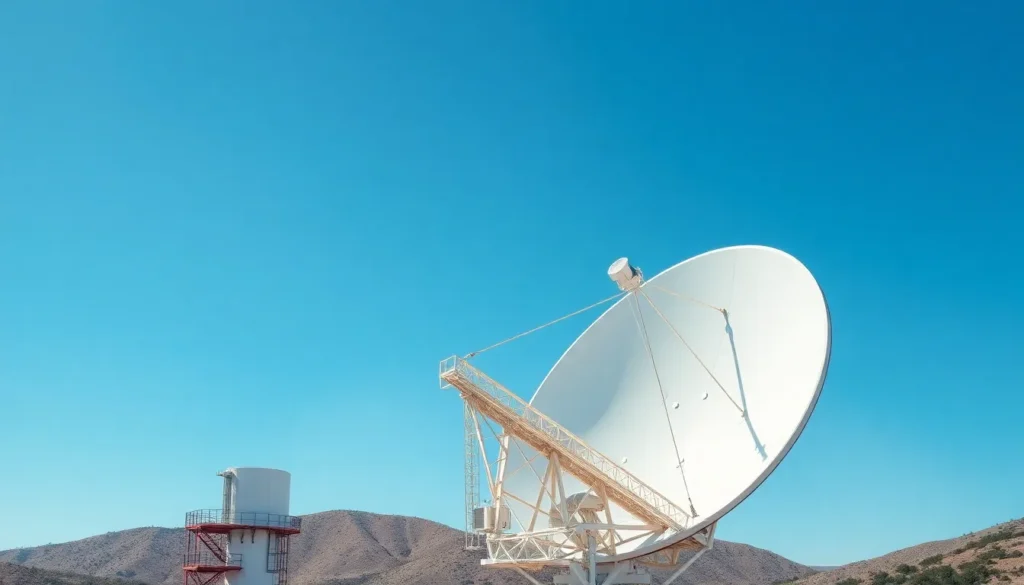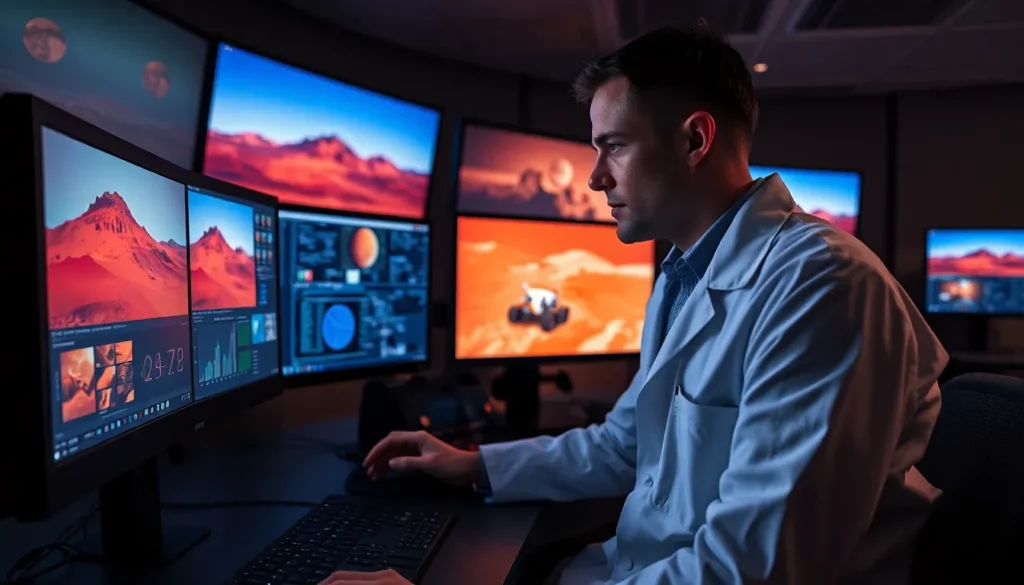Table of Contents
ToggleAs humanity sets its sights on the stars, the question of sustainable space travel has become more pressing than ever. Imagine zipping through the cosmos in a spaceship powered by solar panels and recycled space coffee. Sounds like science fiction, right? Well, it’s closer to reality than you think. With the universe as a playground, the race is on to explore the final frontier while keeping our home planet safe and sound.
Overview of Sustainable Space Travel
Sustainable space travel focuses on environmental stewardship while exploring the cosmos. Solar energy serves as a primary resource for powering spacecraft, reducing reliance on fossil fuels. Recycled materials play a significant role in reducing waste, offering innovative solutions for spacecraft construction. Researchers emphasize closed-loop systems that reuse resources, minimizing environmental impact.
Technological advancements facilitate the development of eco-friendly propulsion systems, such as electric and ion thrusters. Electric propulsion provides higher efficiency, allowing longer missions with lower resource requirements. Companies invest in sustainable technologies, recognizing the need for a balanced approach to space exploration.
International collaboration promotes knowledge sharing, ensuring that best practices in sustainability become standard across the industry. Partnerships between businesses and governmental agencies enhance innovation in sustainable practices, yielding faster progress in this area. Noteworthy projects demonstrate the growing commitment to sustainability, with several missions considering their ecological footprints.
Regulations and guidelines surrounding sustainable practices encourage responsible space exploration. Organizations like the United Nations Office for Outer Space Affairs provide frameworks aimed at protecting celestial environments. Stakeholders must prioritize sustainability to ensure space remains accessible for future generations.
Educational initiatives raise awareness about the importance of sustainable space travel among aspiring scientists and engineers. By engaging younger generations, the industry nurtures a culture focused on responsible exploration. This shift in mindset ultimately fosters a more sustainable future for space travel.
Key Principles of Sustainability in Space Travel

Sustainable space travel relies on several key principles that ensure responsible exploration. These principles prioritize environmental preservation while expanding humanity’s reach into the cosmos.
Resource Management
Effective resource management plays a crucial role in sustainable space travel. Utilizing solar energy, spacecraft can minimize wasteful fuel consumption. Closed-loop systems allow for recycling of water and air, ensuring that valuable resources are not depleted. Prioritizing resource efficiency lowers the overall environmental impact of missions. Efficient technologies, such as electric and ion propulsion systems, further enhance these management practices, enabling longer missions with fewer resources.
Waste Reduction
Waste reduction strategies are essential for environmentally sound missions. Constructing spacecraft with recycled materials significantly decreases the amount of new resources required. Implementing stringent protocols for end-of-life decommissioning aids in curbing space debris. Innovative designs focus on modular components, allowing for repairs and upgrades instead of complete replacements. Fostering a culture that prioritizes sustainability encourages future missions to adapt to eco-friendly practices. Ultimately, these proactive measures contribute to preserving celestial environments for future generations.
Current Technologies Supporting Sustainable Space Travel
Sustainable space travel integrates advanced technologies that support eco-friendly exploration. Two key areas stand out: propulsion systems and renewable energy sources.
Propulsion Systems
Innovative propulsion systems play a crucial role in reducing environmental impact. Electric thrusters have emerged as significant options for sustainability, offering efficiency and lower resource consumption. They utilize electric power to accelerate ions, allowing spacecraft to achieve high speeds with minimal fuel. Ion propulsion systems also provide longer operational lifetimes and enable extended missions with reduced waste. The growing development of hybrid systems combines traditional propulsion methods with these newer technologies, optimizing performance and lowering emissions.
Renewable Energy Sources
Harnessing renewable energy sources marks a vital step in sustainable space travel. Solar energy stands out due to its abundance and efficiency in powering spacecraft. Solar panels convert sunlight into electricity, reducing reliance on fossil fuels. Significant advancements in solar technology further increase energy capture and storage capabilities, ensuring reliable power during missions. Additionally, researchers explore other renewable sources, such as nuclear thermal propulsion, which could provide long-lasting energy for deep-space exploration. Integrating these sustainable energy solutions supports environmentally responsible practices in future space missions.
Challenges to Achieving Sustainable Space Travel
Achieving sustainable space travel involves several significant challenges that impede progress. These challenges encompass economic barriers and technological limitations.
Economic Barriers
Funding remains a critical obstacle for sustainable space initiatives. Many private companies and governmental organizations struggle to allocate sufficient budgets for eco-friendly technologies. High initial investments in sustainable materials and renewable energy systems lead to reluctance among stakeholders. Profitability concerns arise, as sustainable options often have longer payback periods compared to traditional practices. Financial incentives and investments in green technologies can foster innovation. Public-private partnerships may provide necessary resources and shared expertise to overcome economic hurdles. Strategic financing will help align sustainability goals with profit motives, encouraging further development in the industry.
Technological Limitations
Technological advancements are still needed to support sustainable space travel comprehensively. Energy-efficient propulsion systems remain in development stages. While electric and ion thrusters show promise, they require continued refinement for broader application. Limitations in energy storage technologies hinder spacecraft’s ability to maintain extended missions effectively. Closed-loop systems for recycling air and water demand sophisticated engineering not fully realized yet. Air-tight life support systems must evolve beyond current capabilities to minimize waste effectively. Enhanced research and collaboration among scientists will drive breakthroughs, paving the way for a more sustainable future in space exploration.
Future Opportunities in Sustainable Space Travel
Sustainable space travel’s future holds immense potential through innovative solutions and global partnerships. Ongoing research targets breakthroughs in propulsion systems, energy efficiency and resource management.
Innovative Research and Development
Research drives advancements in sustainable space travel. Scientists are focusing on developing lightweight, recyclable materials that can withstand harsh space conditions. They also explore advanced propulsion systems, such as electric thrusters, which maximize efficiency while minimizing resource consumption. Efforts include enhancing solar energy technology to capture and store energy more effectively aboard spacecraft. Innovations in nuclear thermal propulsion offer viable options for long-duration missions, providing a sustainable energy source for deep-space exploration. Ultimately, innovative research paves the way for new technologies and practices that support eco-friendly exploration.
Collaboration Between Nations
Collaboration between nations plays a critical role in fostering sustainable practices in space exploration. Countries are establishing joint ventures to share research and develop technologies that benefit the global community. International partnerships facilitate the exchange of knowledge and resources, promoting standards for sustainable operations in outer space. Agreements among governmental agencies encourage responsible use of environmental resources and minimize space debris. Initiatives like the Outer Space Treaty emphasize cooperation, ensuring that nations work together to protect cosmic environments. Global networking enables different nations to align their sustainability goals, driving innovation toward responsible space exploration.
Sustainable space travel represents a pivotal shift in humanity’s approach to exploration beyond Earth. By embracing innovative technologies and fostering international collaboration, the industry can prioritize environmental stewardship while pushing the boundaries of discovery.
As advancements in propulsion systems and resource management continue to evolve, the dream of eco-friendly space missions becomes increasingly attainable. The commitment to using renewable energy and recycled materials not only minimizes waste but also sets a precedent for responsible exploration.
With ongoing research and partnerships, the future of sustainable space travel is bright, paving the way for a cosmos that respects both our planet and the universe.






